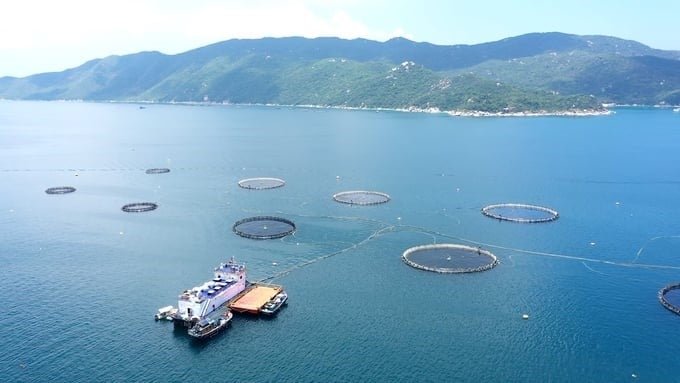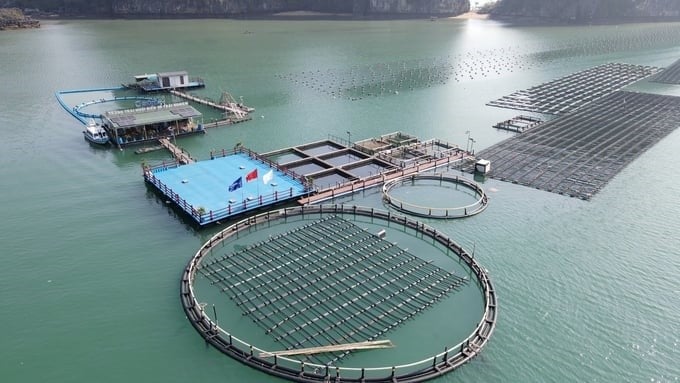November 26, 2025 | 14:27 GMT +7
November 26, 2025 | 14:27 GMT +7
Hotline: 0913.378.918
November 26, 2025 | 14:27 GMT +7
Hotline: 0913.378.918
In recent times, the Party and the State have paid great attention to the issue of marine farming, with the policy of reducing exploitation and increasing aquaculture, focusing on marine farming because inland aquaculture is at a ceiling level.
Marine farming has been included in the Law on Fisheries 2017 and guiding decrees. The Prime Minister also issued Decision No. 1664/QD-TTg approving the project "Developing Marine Aquaculture Until 2030, with a Vision to 2045" and Decision No. 208/QD-TTg approving the project "Converting a Number of Fishing Occupations Affecting Resources and the Ecological Environment."

Marine farming has become a national strategic direction. Photo: Duy Hoc.
With a potential for marine exploitation of 3.9–4 million tons, 3.6 million tons have been exploited, close to the threshold, so reducing exploitation and increasing marine aquaculture (marine farming) is the direction considered by the fisheries industry as a solution to balance human needs with conservation, protection, and development of marine resources.
Dr. Nguyen Chu Hoi, Member of the 15th National Assembly and Permanent Vice Chairman of the Vietnam Fisheries Association, said: "Vietnam's sea is wide, with a large area and a lot of potential for marine farming. Accordingly, the opportunities are great, but there are also many challenges. The policy of developing marine farming was formed early because this is a good way to reduce pressure on marine resources when seafood exploitation in many areas has reached a threshold and long-term alternative solutions are needed. Marine farming has become a national strategic direction."
In recent times, Vietnam has been focusing on developing effective community-based aquaculture models such as seaweed farming, cottonii seaweed farming, or community-based aquaculture models in Phu Yen, Binh Dinh, Ca Mau, Kien Giang,etc. These models are developed according to the co-management method, both managing coastal exploitation and changing occupations for fishermen, thereby helping minimize destructive coastal exploitation activities.
In particular, models of developing community-based tourism combined with marine farming are bringing high economic efficiency to people, encouraging the development of marine farming.
Dr. Pham Anh Tuan, former Deputy Director General of the Directorate of Fisheries, said that the potential to combine marine farming development with tourism is huge, but to do this well, it is necessary to pay attention to three issues. First, it is mandatory to develop green, clean, and beautiful farming areas. Second, building a story is needed to attract tourists so that they will hear stories and learn about marine farming when coming. However, this is not a simple problem. Third, the owner must also be trained in tourism, creating professionalism in this field.

STP Group's marine farm combined with experiences on Phat Co island, Van Don, Quang Ninh. Photo: Duy Hoc.
Sharing the same opinion, Dr. Nguyen Chu Hoi said that not everywhere can combine aquaculture and tourism, but wherever we can, we should do so. However, to have high-quality marine and coastal tourism, the first requirement is to be clean. No one spends money to visit and experience dirty places. Even if they spend money, tourists only come once. Second, this model must be a "check-in" point for tourists. Third, there must be a separate story and a creative, attractive program associated with recreational fishing.
Marine farming associated with tourism will promote natural beauty and increase value for people. However, to harmoniously develop benefits and avoid conflicts, Dr. Nguyen Chu Hoi said that the tool to harmonize those benefits is based on the principle of having a coordination mechanism in action. At the same time, planning must be interdisciplinary and carefully discussed so that all stakeholders are satisfied.
"Developing aquaculture combined with tourism requires creative and attractive programs. Doing so will reduce conflicts, develop multiple benefits, and bring benefits for both sides," Dr. Nguyen Chu Hoi affirmed.
Translated by Thu Huyen

(VAN) After the institutional merger, Da Nang possesses significant forest-carbon reserves and is proactively engaging in the carbon market, creating a new revenue stream.

(VAN) An Giang strengthens communication against IUU fishing, increases inspections and sanctions, and is determined to remove the EC’s “yellow card” while developing a sustainable fisheries sector.

(VAN) As green transition becomes a global trajectory, Viet Nam’s biggest challenge is not only technology and models, but how to ensure that capital flows reach the right beneficiaries.

(VAN) The Ministry of Agriculture and Environment must spearhead the construction of green governance, spanning decision-making processes and investment standards to policy evaluation mechanisms.

(VAN) The Agriculture and Environment sector of Khanh Hoa has achieved numerous milestones over the past 80 years, contributing significantly to the goal of establishing the province as a centrally governed city by 2030.

(VAN) Viet Nam is entering the pivotal period of 2025-2030, moving toward the formulation of the Remote Sensing Law, which will establish a legal foundation for the development of national digital data.

(VAN) The agricultural sector is finalizing the strategic framework for emission reduction, setting the goal of sharply cutting methane and 403.7 million tons of CO2 equivalent and moving toward Net Zero by 2050.